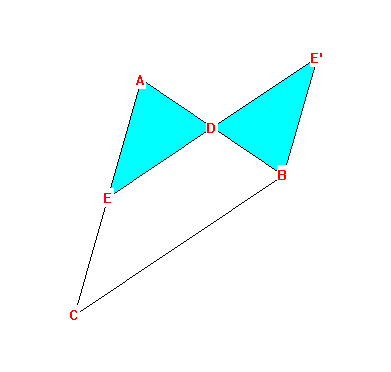DEFINITION: Two figures, F and G,
are Scissors Congruent if one can be cut into polygonal
pieces
which can be rearranged to form the other.
When F is S.Congruent to G we'll write F SC= G .
I. Basic Facts about S. Congruence.
A. If F SC= G then F and G have the same area.
B. (i) F SC= F. (REFLEXIVITY)
(ii) If F SC= G then G SC= F. (SYMMETRY)
(iii) If F SC= G and G SC= H then F SC= H. (TRANSITIVITY)

By rotating the small triangle created by connecting the midpoints
of
two sides of a triangle 180 degrees about one of the midpoints, we
obtain
a parallelogram.
This shows that the triangle's area is the area of this
parallelogram
which can be computed by using the length of the base of the triangle
and
1/2 of its altitude- which is the altitude of the parallelogram.
B. Any polygon can be decomposed into triangles.
THEOREM: Any two polygons F and G of equal area are S.
Congruent.
Proof ( and Procedure ):
1. Decompose both polygons into triangles. (III B.)
F - - S1, S2,..., Sk
G - - T1, T2,..., Tk
2. Each triangle is S. Congruent to a parallelogram. (III A.)
S1 SC= P1, S2 SC= P2 ,...,
Sk SC= Pk
T1 SC= Q1, T2 SC= Q2 ,...,
Tk SC= Qk
3. Each polygon is S.Congruent to a parallelogram . (II D.)
F SC= P , G SC= Q .
4. These parallelograms have equal area, hence they are S.Congruent.
P SC= Q (II C.)
5. F SC= G (I B.)
Notes: